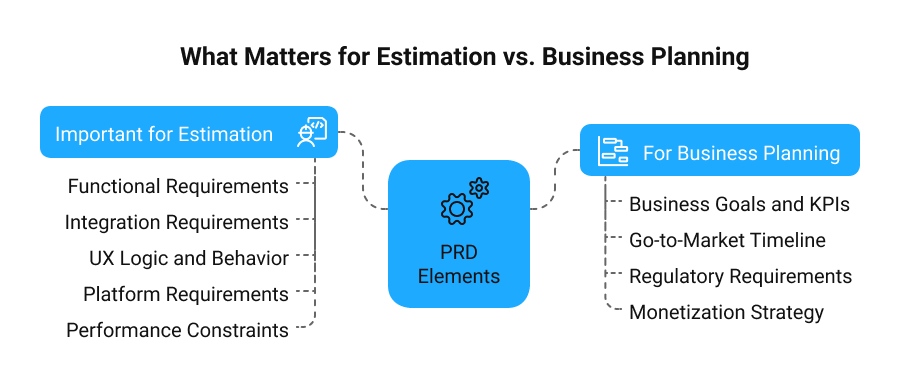
When starting a new software project – whether a cloud platform or firmware for a smart device – the planning phase determines how efficiently your team can deliver.
If you’ve been part of a project that missed its deadlines, went over budget, or ended up far from the original idea, chances are it started with unclear requirements. When the team doesn’t share the same vision of what’s being built, things fall apart quickly. Industry research shows that around 35 % of failed projects are linked to poor requirements definition.
A well-crafted Product Requirements Document (PRD) helps prevent that. It outlines what you’re building, why you’re building it, and how it should behave, helping ensure everyone on the team is aligned and working toward the same goal.
This post will show you how a Product Requirements Document (PRD) can be your project’s north star, ensuring alignment, preventing scope creep, and enabling accurate estimates from day one.
What Is a Product Requirements Document (PRD)?
A Product Requirements Document (PRD) is a comprehensive blueprint that defines what a software product should do, how it should behave, and what business goals it should achieve. Think of it as the bridge between your business vision and technical execution – it translates strategic objectives into actionable development tasks.
Many teams confuse PRDs with other project documents, but each serves a distinct purpose:
- Business Requirements Document (BRD) focuses on high-level business needs and objectives
- Functional Specification details specific system behaviors and user interactions
- Technical Specification outlines the technical architecture and implementation approach
- Product Requirements Document (PRD) sits at the intersection, combining business context with functional details that development teams need
The PRD acts as a crucial bridge between the high-level business goals outlined in a BRD and the detailed technical execution described in functional and technical specifications. It translates the business vision into actionable requirements that the development team can understand, estimate, and implement.
Tip: A good PRD answers three critical questions: What are we building? Why are we building it? How will we know when we’ve succeeded?
5 Reasons Every Project Needs a PRD
A well-prepared Product Requirements Document is much more than just paperwork – it’s a strategic tool that sets the foundation for project success. Here’s why investing time upfront in a clear, detailed PRD pays off throughout your software development journey:
1. Clear Alignment Across Teams
Without a PRD, different stakeholders often have very different interpretations of the same feature – leading to confusion, rework, and delays. A PRD creates a shared understanding by defining user roles, key workflows, functional boundaries, and success metrics from the start. This alignment helps ensure everyone – from developers to executives – is building toward the same goals.
2. Strong Protection Against Scope Creep
“Quick changes” and “small additions” often snowball into major scope expansion. A well-defined PRD sets clear boundaries and priorities, helping teams assess change requests objectively and manage expectations. Including an “Out of Scope” section is especially useful to avoid misunderstandings.
3. Realistic Estimates and Planning
Accurate estimates require clear requirements. Vague input leads to unreliable planning, budget issues, and strained trust. A PRD helps define what’s really being built – including integration points, performance needs, and platform constraints – enabling developers to provide solid estimates and realistic timelines.
4. Faster, Smarter Decision-Making
Trade-offs are inevitable in any project. A PRD offers decision-making context – by documenting priorities, business goals, and technical constraints – so teams can make informed choices when challenges arise without derailing progress.
5. Reduced Risk, Improved Quality
Most project risks stem from poor communication and unclear expectations. A PRD forces teams to address complexity early, reducing rework and late-stage surprises. It also supports better testing, clearer acceptance criteria, and more consistent delivery of business value.

Why PRD Matter Even More in Embedded Projects
Electronics and embedded systems projects face unique complexities that make PRDs even more critical. Unlike pure software projects, these initiatives require perfect synchronization between hardware capabilities, firmware constraints, and software functionality.
Consider a connected IoT device: the PRD must account for power consumption limits, memory constraints, wireless connectivity requirements, and real-world environmental factors. Edge cases that might be easily patched in a web application could require expensive hardware revisions in embedded systems.
The PRD must capture these critical considerations early:
- Hardware-software interface requirements
- Power management and battery life expectations
- Wireless communication protocols and reliability needs
- Environmental testing requirements and certifications
- Update mechanisms for firmware and embedded software
Given these complexities, understanding how to effectively manage software development for consumer electronics becomes crucial for project success. The coordination between hardware and software teams requires specialized approaches that go beyond traditional software project management.
Tip: For electronics projects, involve hardware engineers in PRD reviews to identify potential conflicts between software requirements and hardware limitations before development begins.
The Business Perspective: What Business Owners Must Define
While the technical team relies heavily on the PRD for implementation details, business owners and product leaders play a vital role in defining key aspects that ensure the product aligns with business objectives and market needs.
Even though not everything in the PRD directly impacts the development estimate, certain elements are crucial for business alignment and providing the necessary context for the technical team.
PRD Elements Important for Estimation – these PRD elements directly affect development complexity, timeline, and cost:
- Functional Requirements: Core features and user workflows that define the application’s behavior. A social media app’s posting feature is straightforward; a real-time collaborative editor with conflict resolution is exponentially more complex.
- Integration Requirements: Third-party services, APIs, and system connections add significant complexity. Integrating with a single payment processor differs vastly from supporting multiple payment methods with different authentication requirements.
- UX Logic and Behavior: User interface complexity directly impacts development effort. Simple forms are quick to implement; dynamic interfaces with conditional logic, real-time validation, and complex state management require substantially more development time.
- Platform Requirements: Supporting iOS, Android, web, and embedded platforms multiplies development effort. Each platform has unique constraints, capabilities, and development approaches.
- Performance Constraints: Response time requirements, concurrent user loads, and data processing volumes significantly impact architecture decisions and development complexity.
PRD Elements Important for Business Planning – these elements guide business strategy but have minimal impact on development estimates:
- Business Goals and KPIs: Understanding success metrics helps prioritize features but doesn’t directly affect implementation complexity.
- Go-to-Market Timeline: Launch dates create project constraints but don’t change development requirements.
- Regulatory Requirements: Compliance needs like GDPR or medical device regulations add testing and documentation overhead but typically don’t change core functionality.
- Monetization Strategy: Whether you’re using subscriptions, advertising, or one-time purchases affects business logic but not fundamental development complexity.

Common Pitfalls in PRD and How to Avoid Them
Even with a solid PRD structure in place, it’s easy to fall into common traps that reduce its effectiveness. These issues often lead to miscommunication, unexpected delays, or costly rework. Here are a few mistakes we frequently see – and how to avoid them with a more thoughtful, practical approach.
Writing “too general” requirements
Vague requirements like “the system should be user-friendly” provide little actionable guidance. Instead, focus on specific, measurable, achievable, relevant, and time-bound (SMART) requirements.
Tip: Define specific, measurable criteria, avoid unclear phrases like “Fast performance.” Instead, try something more concrete, such as: “The application’s main dashboard should load in under 3 seconds on a standard network connection.”
Skipping edge cases and exceptions
PRDs often focus on the “happy path”–how features work when everything goes according to plan–while ignoring error conditions, edge cases, and exceptional scenarios.
Tip: For each major feature, document what happens when things go wrong. What occurs when network connectivity is lost? How does the system handle invalid data inputs? What’s the user experience when external services are unavailable?
Assuming the tech team will “figure it out later”
Leaving gaps in requirements with the hope that developers will fill them in during implementation often leads to misaligned expectations, rework, and delays. Developers make the best decisions they can with the information they have – but without clear direction, those decisions might not match your product vision.
Tip: Provide business context for technical requirements. Explain why certain features matter, how they connect to business objectives, and what trade-offs are acceptable.
Failing to update the PRD as the product evolves
A PRD isn’t a one-time document – it should evolve alongside the product. As the project progresses and new insights emerge, it’s crucial to revisit and update the PRD to reflect any changes in requirements or scope.
Tip: Treat PRDs as living documents that evolve with your product knowledge. Establish regular review cycles, designate ownership for updates, and maintain version control to track requirement changes over time.
Get Your Project Started Right with Our Practical PRD Templates
At Developex, we bring deep expertise and a proven process to every project. With over 20 years in software development, we’ve helped companies of all sizes turn ideas into successful digital and electronics-based products.
We know from experience that starting with the right PRD can save you weeks of guesswork and backtracking, significantly cutting down on costly rework and accelerating your path to a successful product launch. This upfront clarity is invaluable, preventing miscommunications and ensuring everyone is aligned from day one.
That’s why we’ve prepared two easy-to-use, practical product requirements document template options, along with filled PRD sample files based on our extensive industry experience. Each includes the essential elements designed to help you define your project with precision:
- PRD Template for Software Projects: Perfect for web applications, mobile apps, SaaS platforms, and other purely software-driven solutions.
- PRD Template for Electronics Projects: Specifically tailored for the complexities of IoT devices, embedded systems development, connected hardware, and any project where software interacts closely with physical components.
Here’s how you can benefit:
Simply download the template that fits your project and fill it out with your specific requirements. Once completed, you have a powerful document to guide your development process.
As an added benefit, you can send your filled-out template to our team at Developex, and we’ll happily provide you with a preliminary, no-obligation estimate for your project. This gives you immediate insight into the potential scope and cost, directly reflecting the detailed planning you’ve already invested.
Even if you choose not to send it to us for an estimate, you can keep and use this valuable document for your own internal development efforts, ensuring a clearer, more organized approach to your project.
Final Thoughts
The Product Requirements Document should not be viewed as a mere bureaucratic hurdle to overcome before the “real” work of development begins. Instead, it should be embraced as a dynamic and collaborative tool that evolves alongside your product. When treated as a strategic asset, the PRD becomes the cornerstone of effective communication, risk mitigation, and ultimately, the delivery of a successful software product that meets both user needs and business objectives.
Whether you’re embarking on a new software initiative, validating early product concepts, or seeking expert guidance to refine your requirements, Developex is here to support you every step of the way – from ideation to successful delivery, with clarity and precision at each stage.






